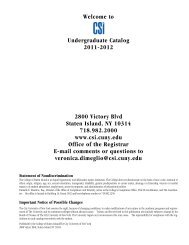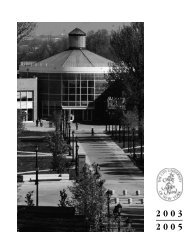Csi undergraduate conference on research, scholarship...
Csi undergraduate conference on research, scholarship...
Csi undergraduate conference on research, scholarship...
Create successful ePaper yourself
Turn your PDF publications into a flip-book with our unique Google optimized e-Paper software.
Social Scientific Methods in<br />
Comparative Perspective<br />
Room 222, 1:30pm–2:55pm<br />
P A P E R 1<br />
The Western Uni<strong>on</strong> Telegraph<br />
Expediti<strong>on</strong> and the Participants’<br />
Views of the Natives They<br />
Encountered<br />
Kelly Cooper<br />
Faculty Mentor: Dr. Susan Smith-Peter<br />
Department of History<br />
Between 1865 and 1868 members of the Western<br />
Uni<strong>on</strong> Telegraph Expediti<strong>on</strong> encountered many<br />
native people <strong>on</strong> their journeys through Alaska and<br />
Siberia. Historians have not given a detailed or<br />
complete account of the Western Uni<strong>on</strong> Telegraph<br />
Expediti<strong>on</strong>, especially the encounters between the<br />
participants and the natives of Siberia and Alaska.<br />
This paper tries to provide this account and examine<br />
a topic that has not been given much c<strong>on</strong>siderati<strong>on</strong>.<br />
This paper c<strong>on</strong>centrates <strong>on</strong> the views of the<br />
expediti<strong>on</strong> participants towards the natives they<br />
encountered <strong>on</strong> their journeys. Based <strong>on</strong> the written<br />
accounts of George Kennan, Richard Bush, and<br />
William H. Dall, this paper argues that all the<br />
participants viewed the natives they encountered as<br />
inferior, and that this opini<strong>on</strong> was shared by the<br />
white American populati<strong>on</strong> at the time. The<br />
expediti<strong>on</strong> members’ views about the natives can be<br />
c<strong>on</strong>nected to the broader white American view that<br />
natives, including Native Americans, were barbarians.<br />
This paper argues that this view c<strong>on</strong>tributed to the<br />
negative view the expediti<strong>on</strong> participants had of the<br />
natives in Alaska and Siberia. This negative view<br />
varied in degree am<strong>on</strong>g the participants, but n<strong>on</strong>e of<br />
them found the natives to be equal. This was<br />
surprising because most of the participants would<br />
have died had the natives not been so helpful in<br />
such terrible c<strong>on</strong>diti<strong>on</strong>s.<br />
P A P E R 2<br />
The Internati<strong>on</strong>al Committee of<br />
the Red Cross and the Terezin<br />
Ghetto<br />
Deryn Cro<br />
Faculty Mentor: Dr. Mark Lewis<br />
Department of History<br />
The Nazis set up the Terezin ghetto in the<br />
Protectorate of Bohemia and Moravia to persuade<br />
the outside world that Jews were being protected<br />
Research Paper Presentati<strong>on</strong>s<br />
within the Third Reich. Even after an investigati<strong>on</strong><br />
by the Internati<strong>on</strong>al Committee of the Red Cross<br />
(ICRC), the Nazis were still able to maintain this<br />
façade. This study focuses <strong>on</strong> the time between<br />
1941-1945 when Terezin was first developed, and<br />
suspici<strong>on</strong>s regarding the Final Soluti<strong>on</strong> began to<br />
increase. Historians have previously speculated that<br />
the ICRC, as a neutral organizati<strong>on</strong>, had its hands<br />
tied with regards to the Holocaust. However, this<br />
<strong>research</strong> hopes to use archival evidence to show<br />
that the ICRC not <strong>on</strong>ly had previous knowledge but<br />
also chose to not act up<strong>on</strong> this informati<strong>on</strong>. It also<br />
seeks to explain why the organizati<strong>on</strong> made the<br />
decisi<strong>on</strong>s it did. Another objective is to explain<br />
why the ICRC made no further inquiries after<br />
visiting Terezin, and the lengths the Nazis went to<br />
in order to cover up the true purpose of the “model<br />
ghetto.” This <strong>research</strong> looks to back up accusati<strong>on</strong>s<br />
that the ICRC failed to provide proper<br />
humanitarian assistance that could have halted the<br />
Nazis’ plans for exterminati<strong>on</strong>.<br />
P A P E R 3<br />
The New York City Mayoralty and<br />
Public Opini<strong>on</strong><br />
Kanika Khanna<br />
Faculty Mentor: Dr. Richard Flanagan<br />
Department of Political Science, Ec<strong>on</strong>omics and<br />
Philosophy<br />
The New York City Mayoralty and Public Opini<strong>on</strong><br />
examines the relati<strong>on</strong>ship between approval ratings<br />
and c<strong>on</strong>diti<strong>on</strong>s/events and <strong>on</strong> the highest political<br />
office of New York City. Through a comparative<br />
study of the mayoral terms of Koch, Dinkins,<br />
Giuliani, and Bloomberg, I note a shift in public<br />
percepti<strong>on</strong> of mayoral performance regarding the<br />
ec<strong>on</strong>omic state of New York City. This study utilizes<br />
both statistical analysis of polling data and<br />
historical analysis of New York City’s political<br />
system. Resources used include polling data,<br />
archives, newspapers, and numerous historical<br />
publicati<strong>on</strong>s. From my <strong>research</strong>, I have c<strong>on</strong>cluded<br />
that the Bloomberg mayoralty is held less<br />
accountable for ec<strong>on</strong>omic downturns than<br />
previous administrati<strong>on</strong>s; however, opini<strong>on</strong>s <strong>on</strong> a<br />
mayor’s effectiveness during ec<strong>on</strong>omic struggle are<br />
influenced by the portrayal of the mayoralty’s<br />
leadership and relatability.<br />
17





